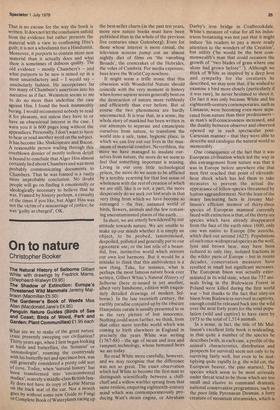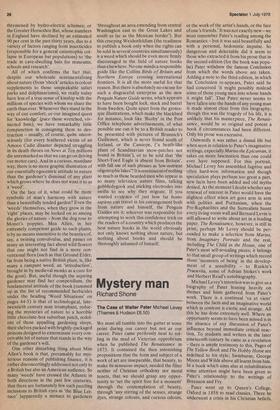On to nature
Christopher Booker
The Natural History of Selbome Gilbert White with drawings by Fredrick Marns, (Shepheard-WalwYn £9.95) The Shadow of Extinction: Europe's Threatened Wild Mammals Jeremy Mallinson (Macmillan £5.50) The Gardener's Book of Weeds Mea Allan (Macdonald Jane's £4.95) Penguin Nature Guides (Birds of Sea and Coast; Birds of Wood, Park and Garden; Plant Communities) £1.95 each What are we to make of the great nature craze presently sweeping our civilisation? Thirty years ago, when I first began looking at birds and butterflies, the 'botanist' or entomologist', roaming the countryside with his butterfly net and specimen box, was Still generally considered a pretty odd sort of cove. Today, when 'natural history' has been transformed into 'environmental studies', scarcely a middle-classfiritish family does not have its copy of Keble Martin on the .back seat of the car. Not a month goes by without some new Guide to Fungi or Complete Book of Waterplants racing up the best-seller charts (in the past ten years, more new nature books must have been published than in the whole of the previous five centuries since Gutenberg). Even for those whose interest is more casual, the television screens pump out an almost nightly diet of films on 'the vanishing Broads', the corncrakes of the Hebrides, the voles of Cumbria. For media exposure, bees leave the World Cup nowhere.
It might seem a trifle ironic that this obsession with Wonderful Nature should coincide with the very moment in history when homo sapiens seems generally bent on the destruction of nature more ruthlessly and efficiently than ever before. But of course the two phenomena are hardly unconnected. It is true that, in a sense, the whole story of mankind has been written in our attempts to separate and emancipate ourselves from nature, to transform the world into a safe, tame, hygienic place, in which we can live out our lives in the maximum of material comfort. Neverthless, the more we have managed to insulate ourselves from nature, the more do we seem to feel that something important is missing. Living in our cosy little technological prison, the more do we seem to be afflicted by a terrible yearning for that lost sense of wholeness with the rest of creation of which we are still, like it or not, a part; the more desperately do we seek our lost souls in that very thing from which we have become so estranged — the free, untamed world of birds, flowers, animals and the few remaining uncontaminated places of the earth.
In short, we are utterly bewildered by our attitude towards nature. We are unable to make up our minds whether it is simply an object, to be probed, taxonomised, despoiled, polluted and generally put to our egocentric use; or the last relic of a beautiful, free, instinctive world which mirrors our own lost harmony. But it would be a mistake to think that this ambivalence is a new thing. Take, for instance, what is perhaps the most famous nature book ever written, Gilbert White's Natural History of Selborne (here re-issued in yet another, albeit very handsome, edition with exquisitely detailed drawings of modern Se!borne). In the late twentieth century, the earthly paradise conjured up by the obscure Hampshire curate is usually presented to us as the very picture of lost innocence. Nothing could seem further, we think, from that other more terrible world which was coming to birth elsewhere in England in precisely the years White was writing (1767-88) — the age of steam and iron and rampant technology, whose bemused, heirs we are today.
Re-read White more carefully, however, and we may recognise that the difference was not so great. The exact observation which led White to become the first man to distinguish scientifically between a chiffchaff and a willow warbler sprang from that same restless, enquiring eighteenth-century mind which was contemporaneously producing Watt's steam engine, or Abraham
Darby's iron bridge in Coalbrookdale. White's measure of value for all his industrious botanising was not just that it might induce 'his readers to pay a more ready attention to the wonders of the Creation', but utility ('he would be the best commonwealth's man that could occasion the growth of "two blades of grass where one alone had grown before" '). Although we think of White as inspired by a deep love and sympathy for the creatures he described, we may note that, if he wished to examine a bird more closely (particularly if it was rare), he never hesitated to shoot it. (In fact it was only because White and his eighteenth-century contemporaries, such as Linnaeus, were becoming even more separated from nature than their predecessors — as man's self-consciousness increased, and the duality between observer and observed opened up in such spectacular postCartesian manner — that they were able to describe and catalogue the natural world so memorably.
One consequence of the fact that it was European civilisation which led the way in this estrangement from nature was that it was in Europe before anywhere else that men first reached that point of eleventhhour shock which has led them to take measures to prevent the actual disappearance of fellow-species threatened by human aggrandizement. Not the least of the many fascinating facts in Jeremy Mallinson's efficient memoir of thirty-three species of European mammal currently faced with extinction is that, of the thirty-six species which have already disappeared from the face of the earth since 1600, only one was native to Europe (the aurochs, which died out around 1627). Populations of such once-widespread species as the wolf, lynx and brown bear, may have been reduced to only tiny, isolated fractions in the wilder parts of Europe — but in recent decades, conservation measures have resulted in small but significant increases. The European bison was actually exterminated in its wild state, when the 737 animals living in the Bialowieza Forest in Poland were killed during the first world war — but thanks to the fact that sixty-six bison from Bialowieza survived in captivity, enough could be released back into the wild over the next forty years for the total population (wild and captive) to have risen by 1973 to the total of 1,514 animals.
In a sense, in fact, the title of Mr Mallinson's excellent little book is misleading, in that quite a number of the species he describes (with, in each case, a profile of the animal's characteristics, distribution and prospects for survival) seem not only to be surviving fairly well, but even to be multiplying quite rapidly (e.g. the wild cat, the European beaver, the pine marten). The species which seem to be most seriously under threat tend to be those which are too small and elusive to command dramatic national conservation programmes, such as the poor little Pyrennean Desman, a furry creature of mountain streams ides, which is threatened by hydro-electric schemes; or the Greater Horseshoe Bat, whose numbers in England have declined by an estimated 90 per cent in the past thirty years, due to a variety of factors ranging from insecticides (responsible for a general catastrophic collapse in European bat populations) to 'the trade in cave-dwelling bats for museums, schools and research'.
All of which confirms the fact that, despite our wholesale sentimentalising about nature (from 'shock' articles in colour supplements to those unspeakable safari parks and dolphinariums), we really today have less of a true sense of kinship with the millions of species with whom we share the earth than ever. Whenever they stand in the way of our comfort, or our imagined quest for 'knowledge' (pace those wretched, vivisected bats), we have remarkably little compunction in consigning them to destruction — usually, of course, quite unconsciously (for every feathered victim of an Amoco Cadiz disaster depicted struggling in its death throes on News at Ten millions die unremarked so that we can go on driving our motor cars). And in a curious, mundane way, there is no more graphic illustration of our essentially egocentric attitude to nature than the gardener's dismissal of any plant which grows where he does not want it to as a 'weed'.
On the face of it, what could be more symbolic of man's harmony with nature than a beautifully tended garden? Even the 'weeds' themselves, when they grow in the 'right' places, may be looked on as among the glories of nature — from the dog rose to Monet's poppies. Mea Allen, in her extremely competent guide to such plants, is by no means insensitive to the beauties of, say, a twining convolvulus, and passes on many an interesting fact about wild flowers that one might not find in a more conventional flora (such as that Ground Elder, far from being a native British plant, is, like many a rampant weed, an 'introduction', brought in by medieval monks as a cure for the gout). But, useful though the aspiring gardener may find her compendium, the fundamental attitude of the book (summed up in the list of recommended herbicides under the heading 'Weed Situations' on pages 44-5) is that of technological, latetwentieth century man triumphant, reducing the mysteries of nature to a horrible little chocolate-box suburban patch, redolent of those appalling gardening shops, their shelves packed with brightly-packaged poisons designed to exterminate every conceivable bit of nature that stands in the way of the gardener's will.
One other disturbing thing about Miss Allen's book is that, presumably for mysterious reasons of publishing finance, it is rather disconcertingly addressed not only to a British but also an American audience. So many 'weeds' have crossed the Atlantic in both directions in the past few centuries, that there are fortunately few such puzzling inclusions to British eyes as 'the Blue Lettuce' )apparently a menace to gardeners 'throughout an area extending from central Washington east to the Great Lakes and southas far as the Mexican border'). But this creeping Weidenfeldism (the readiness to publish a book only when the rights can be sold in several countries simultaneously) is a weed which should be even more firmly discouraged in the field of nature books than elsewhere. No one minds a responsible guide like the Collins Birds of Britain and Northern Europe crossing international frontiers. It is all the more useful for that reason. But there is absolutely no excuse for such a disgraceful enterprise as the new Penguin Nature Guide series, which appears to have been bought lock, stock and barrel from Sweden. Quite apart from the grotesque illustrations, which make the blackbird for instance, look like 'Buzby' in the Post Office telephone advertisements, of what possible use can it be to a British reader to be presented with pictures of Brunnich's Guillemot, which is never found south of Iceland, or the Cassiope, Ca heath-like plant of Scandinavian snow-patches not found in Britain'), or to be told that 'the Short-Toed Eagle is absent from Britain', with full use of such phrases as low-nutrient oligotrophic lakes'? It is reminiscent of nothing so much as those bearded men who appear in so many television nature films, talking gobbledygook and sticking electrodes into swifts to see why they migrate. If, you wanted evidence of just how far homo sapiens can travel in his estrangement both from nature and himself, the Penguin Guides are it: whoever was responsible for attempting to work this confidence trick on the readers of a country which produces the best nature books in the world obviously not only knows nothing about nature, but nothing about books and should be thoroughly ashamed of himself.







































 Previous page
Previous page